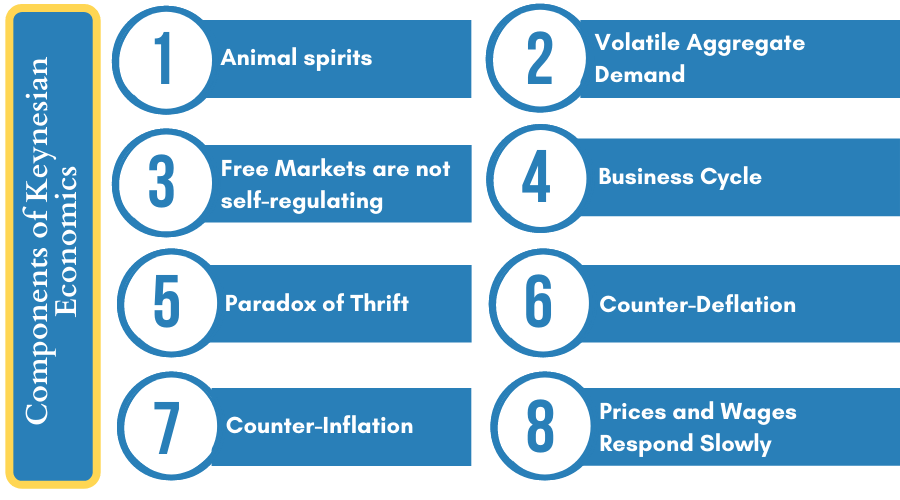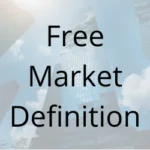Keynesian Economics: Definition & How It’s Used
What is Keynesian Economics
Keynesian economics is a school of thought that originated from economist John Maynard Keynes in the late 1930s. Its basic premise is that government intervention should be used to stabilize the economy.
Following the Great Depression between 1929 and 1933, Keynes highlighted the inability of free markets to increase employment. The consensus at the time was that employment would rise if employees were flexible with their wage demands. However, unemployment boomed in the US – increasing from 3.2 percent in 1929 to 24.9 percent by 1933.
Key Points
- Keynesian economics is based on the idea that government is required to stabilize the economy.
- Key policies of Keynesian economics are to increase government spending and reduce taxes (fiscal policy) to boost aggregate demand.
- One of the major criticisms of Keynesian economics is that it leads to huge budget deficits and government debt. If not managed effectively, it can lead to a generational economic crash as seen in the likes of Greece.
If free markets worked, Keynes wondered why unemployment would rise so quickly and un-relentlessly. How could the economy escape from this trap of decreasing unemployment and decreasing demand?
The issue with recessions is that aggregate demand in the economy falls. This means consumers are buying fewer goods and services. In turn, the economy needs fewer people employed. So employers let go of excess employees as they put a drain on the firm’s resources. This perpetuates a further decline in the economic and a further increase in unemployment.
Keynes saw this as a vicious cycle which could only be stopped by government intervention. He saw aggregate demand as the most important part of the economy – which was made up of consumer spending, business investment, government spending, and net exports. However, when consumer spending and business investment falls, Keynes believed that it was necessary to increase government spending to compensate and stabilize the economy.
Keynesian Multiplier
Keynes was a strong advocate for government spending. The main reason for such was due to what is known as the ‘Keynesian Multiplier’. Essentially, this is the idea that $1 spent by the government would create a multiplying effect through the economy. So the $1 would translate into $2 of economic growth – thereby representing greater value to the economy. Even if the government has to pay 5 percent in interest, the net benefit to the wider economy is seen to exceed this value.
“The initial $1 is spent by one person, who then spends it again, with the next person then spending it once again – thereby creating a multiplier effect in the economy. “
Keynesian economists believe that when aggregate demand is decreasing, government spending is able to step in a create a multiplying effect in the economy. The concept is that the government employs someone who is out of work. They are given money by the government and then consequently spend that in the wider economy. That demand then stimulates jobs in other areas – creating jobs and income for those employees. This then continues on and on until the $1 spent translates into a multiple which has created many jobs in the economy.
The Keynesian multiplier is also applicable when government reduces spending – although in the opposite way. For example, a $1 reduction in spending may in fact have a $2 decrease in economic activity. Therefore, Keynesian economists believe that the austerity measures that European countries adopted was actually counter-productive following the Financial Crisis.
Components of Keynesian Economics
The idea of Keynesian economics is fundamentally structured on the basis that weak aggregate demand can lead to periods of sustained unemployment. Keynes argued that this could be combated through an increase in government spending to help stabilize the economy. However, there are many other components to his argument, such as:

1. Animal spirits
One of the key parts of Keynesian economics is what John Maynard Keynes termed as ‘animal spirits’. This is the nature of human behaviour and thinking which drives businesses and consumers to behave in certain ways. It refers to a broad psychological outlook of businesses and consumers and includes their confidence, trust, mood and expectations.
When a populations animal spirits are poor, there is low business and consumer confidence. In turn, this psychological affect has a wider impact on the economy. Low levels of confidence tend to lead to lower levels of aggregate demand because consumers hold back on purchases and businesses hold back on investments. Whilst consumers are anxious about their future employment, businesses are uncertain about future demand.
2. Volatile Aggregate Demand
As a result of animal spirits, Keynesianism highlights the issues surrounding volatile aggregate demand. This can fluctuate depending on consumer and business confidence in the economy. As this is dependent on the confidence, trust, and mood of humans – this can be extremely volatile.
At the same time, aggregate demand can also be dependent on demand from overseas. If exports are weak, this can have a ripple effect throughout the economy. Businesses that rely on exports will see less trade and therefore hire fewer workers. This then has a subsequent effect on demand in the economy which has the potential to create a ripple effect which can affect millions of jobs throughout the economy.
3. Free Markets are not self-regulating
During the years of the Great Depression, the free market was seen to have done little to regulation unemployment. In the years between 1929 and 1933, unemployment sky-rocketed, and despite falling wages, people were unable to find work.
Keynes believed that the free market could not regulate itself because it was controlled by human psychology and ‘animal spirits’. Once a negative outlook was established, it can become self-fulfilling – which is why government intervention is needed to break that downward spiral.
4. Business Cycle
Economies go through periods of economic growth and periods of recession. During periods of growth, Keynesian economics believes that governments should reduce their spending in order to counter inflation. However, this was largely based on the premise that unemployment was falling. This was because full employment was a key aim of Keynesianism.
5. Paradox of Thrift
The paradox of thrift refers to the increase in saving that results during a recessionary period. As a result of a downturn in economic activity, people tend to save more in order to protect themselves if they lose their jobs. In turn, this can exasperate the economic downturn as aggregate demand falls further, thereby creating more job losses in the economy. This is seen to create a multiplier effect whereby one individual saving $50 can actually create an exponential drag on the economy which may have an impact of $1,000.
Greater consumer saving means less spending. Businesses see the lower levels of demand and subsequently reduce the amount of investment – thereby exasperating the recession further.
6. Deflation
During the period by which Keynes wrote his book ‘The General Theory of Employment, Interest, and Money’, deflation was persistent and extensive. This can be dangerous for the economy – particularly if consumers become accustomed to deflation. When consumers expect deflation, they start to hold off on purchases for next year as the product will be cheaper. In turn, this can put a further drag on the economy as consumers put off their purchasing decisions.
There is also the aspect of private and public sector debt. When there is deflation, it becomes more difficult to pay back existing debt. Revenues fall, but the level of debt due remains constant – meaning a real increase in the debt rate.
7. Counter-Inflation
Keynes noted deflation and saw the damage it did. Keynesian economics sees deflation as a job killer. Yet too much inflation can have a similar effect. This is why Keynes believed that governments should expanding their spending during periods of recession, but cut back during periods of growth.
In Keynesian economics, the aim is the counter-demand in order to create stability. Therefore, when consumer demand is increasing and the economy is heating up – government should reduce its involvement as it can crowd out private spending and reduce economic growth. At the same time, excess government spending can lead to inflation – so it is important to reduce this during periods of growth.
8. Prices and Wages Respond Slowly
Keynesian economics highlights the fact that prices and wages respond slowly to changes in demand. They lag behind as most businesses will only notice a drop off in demand months or years after. For example, stores may see a small drop off in demand in one quarter, but may attribute this to other factors. It may only become apparent after 3 to 6 months that demand has become persistently lower than previously.
In turn, businesses start expecting continued lowering of demand and so lower prices, restrict wage increases, and potentially let workers go. This can lead to surplus production when the economy starts to shrink, and shortages when the economy starts to expand again.
Keynes saw this as a weakness of capitalism and suggested that government spending would be able to accelerate this process during growth, and slow down and prevent a prolonged recession.
Aims of Keynesian Economics
Full Employment
Keynes saw employment as the key to boosting aggregate demand and economic growth. The logic goes that if people are without employment, they are not able to afford goods. If they have employment, they can buy goods which in turn and boost employment opportunities – thereby creating a multiplying effect.
The aim of Keynesian economics was to ensure that employment was always kept at the maximum to ensure economic stability. If everyone has employment, then there is enough demand to stimulate economic activity. The issue is that when employment declines, it can create a domino effect whereby the reduced demand filters through the economy.
Keynes noted this effect and believed then when unemployment started to increase, government should step in so that the negative impacts do not ripple through the economy.
Economic Stability
Economies are chaotic as they go through the business cycle of growth and recession. Keynes believed that this was driven by the nature of animal spirits. The psychological effect of an economic recession was for people to save more. However, Keynes noted that this was the exact opposite of what was needed to counter-balance the forces of declining aggregate demand.
It was only in human nature to save, but this has a negative effect on economic stability. With this macroeconomic knowledge, Keynesian economics believes that economic stability can only be achieved by counter-balancing these natural human reactions to uncertainty. The answer is seen to be through government intervention through employment programs and a reduction in taxes.
Price Stability
During the Great Depression of 1929-33, the value of the dollar declined by roughly one-third. The deflationary pressures of the time were not well understood and only exasperated the recession at the time. Consumers put off purchasing decisions, and the wider uncertainty prevented people from spending and stimulating the wider economy.
Keynesian economics aims at achieving price stability in order to prevent excessive levels of inflation or deflation. This is because huge swings either way can create consumer uncertainty. By maintaining small and consistent levels of inflation, consumers have the certainty that prices will rise next year, but not at a rate by which would dramatically heat up the economy.
Counter-Demand
As part of maintaining stability, Keynesian economics looks to counter the behaviour of consumers and the economic environment. It does this by assessing unemployment and wider economic indicators such as GDP. When the economy is heating up and unemployment is falling, it is necessary to reduce government involvement so as not to contribute to a crowding out effect and potential inflation.
On the other side of the coin, when economic activity is declining and unemployment is increasing – government should step in by providing employment programs, investment, and lowering taxes to boost consumers purchasing power.
Criticisms of Keynesian Economics
Budget Deficit
Keynes advocated for government spending to boost aggregate demand – especially during periods of recession. However, during this time, government revenues are lower and increasing spending means the budget deficit increases two-fold. In the long-term, a consistent budget deficit can lead to excessive levels of government debt, whilst also making it more difficult for it to borrow further. It may have to increase interest rates to attract buyers of debt.
At the same time, this can create a debt trap as can be seen in Greece. Excessive budget deficits have meant that it needs to borrow in order to finance previous debt. However, it is paying a higher interest rate to do so.
Government Debt
By borrowing more money to stimulate the economy, the government accumulates debt. Keynesian economics does not explicitly state that government debt should not exceed a certain amount – instead, it assumes that the money invested will be paid back through higher tax revenues.
At the same time, increasing government debt has other issues. It can lead to a crowding out of private investment as there is less credit available. In turn, this can also lead to capital flight whereby investors more their money abroad. When government debt is high, investors can become uncertain about the nation’s ability to pay it back – which can put their investments at risk.
There is also the issue of increasing interest rates which are needed in order to attract further levels of investors. This means that in the long term, governments will end up paying huge sums purely on interest alone. For example, the US pays nearly $400 billion in interest alone. To put that into perspective, the interest payments made by the US are nearly as large as the economy of Sweden.
Crowding Out
As government debt increases, it puts pressure on interest rates as government have to start offering higher rates to attract investors. In turn, this puts additional pressure on private enterprises, as it becomes more expensive for them to obtain credit.
The crowding out effect has an impact on the remainder of the market and can impact on either the demand or supply side. For example, when government increases its spending, it is essentially competing against private entities. When it hires a worker, it is one less that the private sector can hire. When it borrows money, it makes it more difficult for the private sector to borrow those same funds.
Capital Flight
One of the arguments against Keynesian economics is that over the long-term, government debt can increase to significant levels. Alongside increased governmental involvement, this can lead to great uncertainty for investors. Perhaps the government will default on their debt, or investors may not get all their investment back.
At the same time, excessive levels of government borrowing and spending can contribute to inflationary pressures in the economy. As we have seen in the likes of Venezuela, this can lead to excessive levels of inflation. In turn, such inflation can deflation the value of investors assets which can lead many to take their investments elsewhere.
Monetary Policy Criticisms
Keynes advocated for the use of fiscal policy to help boost the economy. He saw monetary policy as an ineffective method in influencing demand. However, it has now been commonly accepted that monetary policy is a useful way to boost aggregate demand in the economy.
Many nations use the adjustment of interest rates to increase or decrease the flow of money in the economy. Open market operations are also useful to ensure that there is enough money in the economy to represent the goods being produced. And the use of reserve requirements can restrict the supply of money to the wider economy.
These monetary tools effectively act as a tap which can help inject money and credit into the wider economy. By inject cheap credit into the market, it provides businesses with greater levels of capital and cash flow to invest and consumers to buy.
Political Cost
One of the criticisms surrounding Keynesian economics is that it leads to bigger governments and increased corruption. It is often argued that governments end up spending money on useless projects which are created due to vested interests. Often this then proves too difficult to cut back once the recession is over.
As we can see in the United States, there are now billions spent on lobbying efforts in order to obtain subsidies and other favourable conditions. This is because the government has become so involved in the wider economy. It has become profitable for firms to invest such sums in order to get favourable deals.
FAQs on Keynesian Economics
In simple terms, Keynesian economics is the idea that fiscal policy in the form of government spending and taxation, are useful in counter-balacing aggregate demand, particularly during recessionary periods. It is used to boost the economy and step in to replace lower levels of consumer and business spending in the economy.
The main points of Keynesian economics is that declining demand can become self-fulfilling. Consumers demand less, which impacts on employment in the wider economy. This then reduces their purchasing power, which affects further jobs. This is known as the Keynesian multiplier effect.
Part of this evolves around the multiplying effect that consumption has. Keynes argued that $1 in government spending would have a multiplying effect which would boost the economy in excess of the originaly $1 – which would prove a worthwhile investment.
Keynesian economics is not so widely used today after the stagflation that occured in the 1970s and 80s. However, government plays a large role in the economy and accounts for significant expenditures. Instead of being used to boost the economy in bad times, government spending has generally increased whether the economy is in a recession or not. This goes against Keynesian economics which is to counter-balance the cyclical nature of aggregate demand.
About Paul
Paul Boyce is an economics editor with over 10 years experience in the industry. Currently working as a consultant within the financial services sector, Paul is the CEO and chief editor of BoyceWire. He has written publications for FEE, the Mises Institute, and many others.

Further Reading
 Free Market: Definition, Pros, Cons & Examples - A free market is where the people in an economy are free to engage in economic activities and transactions without…
Free Market: Definition, Pros, Cons & Examples - A free market is where the people in an economy are free to engage in economic activities and transactions without…  GNP: Definition, Formula, How to Calculate & Example - Gross National Product (GNP) refers to the total value of goods and services where the means of production is owned…
GNP: Definition, Formula, How to Calculate & Example - Gross National Product (GNP) refers to the total value of goods and services where the means of production is owned…  Collective Bargaining: Definition, Types & Examples - Collective bargaining is the process where a group of employees ‘collectively’ negotiate with the employer.
Collective Bargaining: Definition, Types & Examples - Collective bargaining is the process where a group of employees ‘collectively’ negotiate with the employer. 
